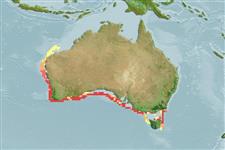Actinopterygii (ray-finned fishes) >
Ophidiiformes (Cusk eels) >
Ophidiidae (Cusk-eels) > Neobythitinae
Etymology: Dannevigia: Because of harald Kristian Dannevig (1871-1914). He was appointed by the NWS Government in Australia as superintendent of fisheries and investigation in 1902. More on author: Whitley.
Environment / Climate / Range
Ecology
Marine; benthopelagic; depth range 115 - 400 m (Ref. 9563). Temperate, preferred ?
Eastern Indian Ocean: Great Australian Bight, straying to Bass Straits (Australia).
Size / Weight / Age
Maturity: Lm ? range ? - ? cm
Max length : 56.0 cm TL male/unsexed; (Ref. 9563)
Short description
Morphology | Morphometrics
Body robust, deepest over pectoral fins; several short, weak, concealed spines at lower angle of preopercle; spine on opercle barely if at all reaching beyond rear margin of head; eyes well developed; adults with no dark spots on body or fins; pelvic fin bases close together, inserting under rear margin of eye. Small specimens with 4 rather diffuse broad vertical brown bands on body; adults uniformly brown (Ref. 34024).
A benthic species found on the continental slope (Ref. 75154). Common species (Ref. 34024). Oviparous, with oval pelagic eggs floating in a gelatinous mass (Ref. 205). Minimum depth reported from Ref. 34024.
Life cycle and mating behavior
Maturity | Reproduction | Spawning | Eggs | Fecundity | Larvae
May, J.L. and J.G.H. Maxwell, 1986. Trawl fish from temperate waters of Australia. CSIRO Division of Fisheries Research, Tasmania. 492 p. (Ref. 9563)
IUCN Red List Status (Ref. 115185)
CITES (Ref. 94142)
Not Evaluated
Threat to humans
Harmless
Human uses
Fisheries: minor commercial
More information
Age/SizeGrowthLength-weightLength-lengthLength-frequenciesMorphometricsMorphologyLarvaeLarval dynamicsRecruitmentAbundance
ReferencesAquacultureAquaculture profileStrainsGeneticsAllele frequenciesHeritabilityDiseasesProcessingMass conversion
Tools
Special reports
Download XML
Internet sources
Estimates of some properties based on models
Phylogenetic diversity index (Ref.
82805): PD
50 = 1.0000 [Uniqueness, from 0.5 = low to 2.0 = high].
Bayesian length-weight: a=0.00102 (0.00046 - 0.00225), b=3.06 (2.88 - 3.24), in cm Total Length, based on all LWR estimates for this body shape (Ref.
93245).
Trophic Level (Ref.
69278): 3.7 ±0.6 se; Based on size and trophs of closest relatives
Resilience (Ref.
69278): Medium, minimum population doubling time 1.4 - 4.4 years (Preliminary K or Fecundity.).
Vulnerability (Ref.
59153): Moderate to high vulnerability (46 of 100) .
